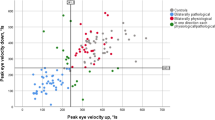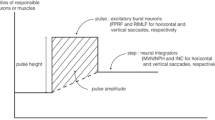Abstract
Eye-movement recordings may be helpful in the differentiation of Duane's syndrome from sixth-cranial-nerve palsy. Voluntary horizontal saccades were recorded and quantitated by electrooculography in 18 patients with unilateral type I Duane's syndrome and in 25 patients with sixth-nerve palsy. When ranges of abduction were matched, the peak velocities of abducting saccades in affected eyes were decreased equally in both groups. However, the peak velocities of adducting saccades in sound eyes were slowed in patients with Duane's syndrome. Because the standard deviations in saccadic velocities are large, computer-based, stepwise discriminant analyses were performed to identify the variables that proved to be useful in differentiating the two disorders. By entering these variables into the discriminant functions that were created, we could distinguish Duane's syndrome from sixth-nerve palsy in a statistically significant manner.
Similar content being viewed by others
References
Baloh RW, Langhofer L, Honrubia V, Yee RD (1980) On line analysis of eye movements using a digital computer. Aviat Space Environ Med 51:563–567
Blodi FC, Van Allen MW, Yarbrough JC (1964) Duane's syndrome: a brain stem lesion. Arch Ophthalmol 72:171–177
Breinin GM (1959) Electromyography. A tool in ocular and neurologic diagnosis. Arch Ophthalmol 57:165–175
Dixon WJ (ed) (1981) BMDP statistical software 1981. University of California Press, Berkeley
Gourdeau A, Miller N, Zee S, Morris J (1981) Central ocular motor abnormalities in Duane's retraction syndrome. Arch Ophthalmol 99:1809–1810
[Reference deleted]
[Reference deleted]
Huber A (1974) Electrophysiology of the retraction syndrome. Br J Ophthalmol 58:293–300
Metz HS, Scott AB, O'Meara D, Stewart HL (1970) Ocular saccades in lateral rectus palsy. Arch Ophthalmol 84:453–460
Metz HS, Scott AB, Scott WE (1975) Horizontal saccadic velocities in Duane's syndrome. Am J Ophthalmol 80:901–906
Nemet P, Ron S (1978) Ocular saccades in Duane's syndrome. Br J Ophthalmol 62:528–532
Sato S (1960) Electromyographic studies on Duane's retraction syndrome. Jpn J Ophthalmol 4:57–66
Scott AB, Wong GY (1972) Duane's syndrome: an electromyographic study. Arch Ophthalmol 87:140–147
Strachan IB, Brown BH (1972) Electromyography of extraocular muscles in Duane's syndrome. Br J Ophthalmol 56:594–599
Yee RD (1983) Eye movement recording as a clinical tool. Ophthalmology 90:211–222
Author information
Authors and Affiliations
Additional information
This research was supported in part by a Manpower Award from Research to Prevent Blindness, Inc. (J.B.B.), the Dolly Green Research Scholar Award, RPB Inc. (R.D.Y.), and NEI grant EY068772 (J.B.B.)
Offprint requests to: J. Bronwyn Bateman
Rights and permissions
About this article
Cite this article
Yang, M.C., Bateman, J.B., Yee, R.D. et al. Electrooculography and discriminant analysis in Duane's syndrome and sixth-cranial-nerve palsy. Graefe's Arch Clin Exp Ophthalmol 229, 52–56 (1991). https://doi.org/10.1007/BF00172261
Received:
Accepted:
Issue Date:
DOI: https://doi.org/10.1007/BF00172261




